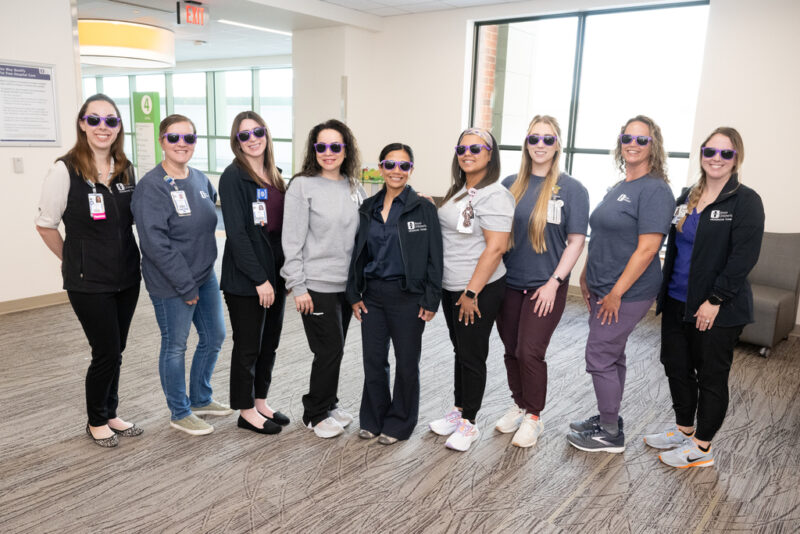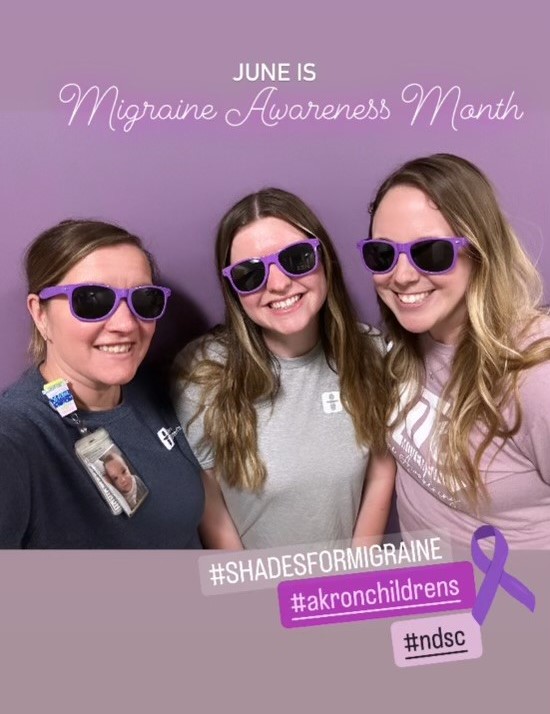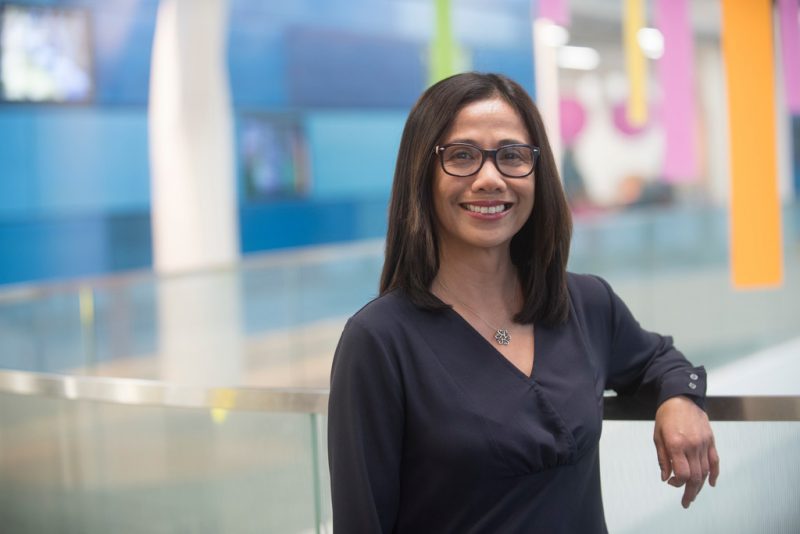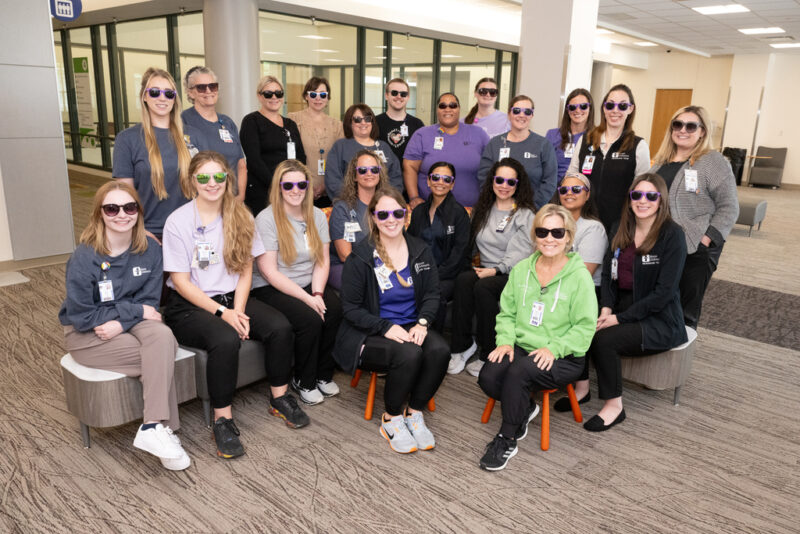
Akron Children’s Headache Program Team
June is National Migraine and Headache Awareness Month and Akron Children’s is tackling this common complaint that can easily derail childhood and adolescence with an expanded team of providers, dedicated headache and infusion clinics, and a commitment to research, quality improvement and education. Here’s an overview:
Akron Children’s Headache Program is led by Dr. M. Cristina Victorio, a pediatric neurologist who has completed fellowships in child neurology and headache medicine. She has been in practice since 2008.
Joining her is Dr. Kelsey Merison, a pediatric neurologist with special interest in headaches and migraine; Dr. Sarah Love, a pediatric headache and pain psychologist who provides behavioral health interventions alongside the medical interventions; and Danielle Freeman, APRN-CNP, a nurse practitioner who runs the migraine infusion clinic. They are supported by a team of specially-trained nurses: Angela Holmes (headache program nurse coordinator), Katherine Miller, Megan Maranville, Brooke Fowler, Jillian Vasiloff, Jenna Spuhler, Leah Ott, and Luda Kalain, and administrative support staff, Margie Pownall.

According to Dr. Victorio, nearly 60 percent of children and teens complain of headache at some point and 1 in 11 of them have migraine headaches.
Compared to adults, migraines in young people are shorter and usually located on both sides of the head instead of one sided and can have predominant GI symptoms such as belly pain, nausea and vomiting. Children also have a harder time describing their symptoms and understanding the impact of their pain, hence migraines in children and teens are either under-recognized, misdiagnosed or untreated. Similar to adults, migraines in children leads to substantial amount of functional disability that affects them at school, home and their social and extra-curricular activities. Therefore, the earlier they are diagnosed, the better.
“The earlier you have the diagnosis, treatment, prevention and awareness of potential triggers, the better are your chances to control them,” said Dr. Victorio. “Early treatment increases the likelihood that these patients will be successful in managing migraine through their lives.”
The providers treat pediatric patients with a variety of headache disorders, chronic headaches including the progression into chronic migraines. These patients, by definition, typically have 15 or more headaches or migraines per month with pain, nausea, and light sensitivity as common symptoms.
“Some of these kids are so debilitated by chronic headaches,” Dr. Victorio said. “They will say, ‘I used to be a straight A student and now I’m struggling to concentrate because of the pain. I am no longer in sports or band because of the strenuous activity and loud noises bother me. Others will tell me they are taking medicine after medicine, which gives them side effects. Our program is dedicated to helping our youths in managing migraines and frequent headaches and keep it from overtaking their lives.”

Dr. Cris Victorio is a pediatric neurologist, with a special interest in headache and migraine.
The Comprehensive Approach: Multi-Disciplinary Clinic and Infusion Clinic
Migraine treatment can be challenging. Studies have shown that medications alone are not enough and a combination of pharmacotherapy and behavioral therapy is recommended. The majority of headache patients are managed by primary care providers or child neurology providers. For the more challenging cases, the headache team aims to offer comprehensive care in a one-stop-shop fashion. The team sees patients in a multi-disciplinary clinic format, so the headache specialists, headache psychologist and nurse educator are available on the same day.
Teens may experience prolonged migraines and sometimes at-home treatment does not work. In these cases, the infusion clinic allows established Neurology patients in the middle of an uncontrollable migraine to bypass the ER and receive IV treatment to break their headache cycle. This treatment combines IV fluids, a nonsteroidal, an anti-inflammatory drug, an antihistamine, and an antiemetic – in a calming, dimly-lit room. During the visit, headache NP, Danielle Freeman, assesses the appropriate IV medications needed; and our infusion-trained nurses will administer medications, check vitals and assess response to medications.
Other Migraine and Headache Treatments
The headache program provides treatments beyond the typical oral migraine medications. The headache specialists are also trained to perform procedural interventions such as Onabotulinum toxinA (Botox) for chronic migraine and peripheral nerve blocks.
Psychologist Dr. Sarah Love helps patients prevent their headaches with various types of behavioral therapies such as progressive muscle relaxation, paced breathing, cognitive behavioral therapy and mindfulness-based therapies. Because pill swallowing can be a barrier to successful treatment in some patients, Dr. Love also provides pill swallowing training.
Research
Dr. Victorio has been committed to research since her arrival, and has two clinical trials on calcitonin gene-related peptide (CGRP) targeted therapies currently underway. This is the newest wave in migraine treatment.
One is a phase 3 multi-center study on testing the safety and efficacy of Rimegepant for the acute treatment of migraine in patients 12 to 17 years. The second is a phase 3 trial on the safety and efficacy of Eptinezumab for prevention of episodic migraine in patients 6-17 years. Both studies are currently accepting new patients.
A culprit in migraine, CGRP, is a protein that plays a role in generating the head pain of migraine. Dr. Victorio is excited about the CGRP inhibitors that are currently FDA approved for adults.
“For adults, they are the game changer. There are fewer side effects and compliance is better with a monthly injection or infusion every 3 months.”
But, she says, the costs need to come down and clinical trials need to prove they are safe and effective for children and teens.
Quality Improvement, Education and Awareness
With headaches and migraine so common and pediatric headache specialists so limited in how many patients they can manage, the headache team puts a high priority on quality improvement projects and educating and empowering primary care providers.
As part of their QI initiative, the team implemented a Migraine Action Plan to help patients manage migraine effectively while at home and at school. This action plan includes tools on how to advocate for accommodations at school under Section 504 of the Rehabilitation Act of 1973, a federal law designed to protect the rights of individuals with disabilities.
Some of the recommendations are allowing for a water bottle at school at all times to stay hydrated, encouraging quick breaks on computer screens to avoid eye strain, and allowing extended time to do homework should the patient experience a migraine.
An ambulatory smart set was created to assist Akron Children’s primary care providers manage headache disorders. Dr. Merison and her team have created a headache clinical pathway which has been linked to the primary care headache smart set and an E-consult order. The goal of these initiatives is to encourage and empower primary care providers to start first-line treatments for primary headache disorders, reduce the number of patients waiting to be seen in Neurology and, overall, improve access for headache patients who need neurological evaluation the most.
The headache team also plans to expand headache educational activities by venturing into the education for school nurses and teachers.
“The headache team is dedicated in improving the lives of children and teens with migraine and headache disorders,” said Dr. Victorio. “Education and advocacy are some tools to reach these goals. Tell your stories and join us to increase awareness for migraine and headaches in this month of June!”

Akron Children’s Headache Program Team










